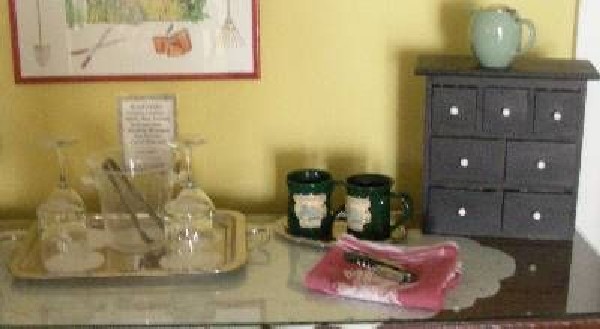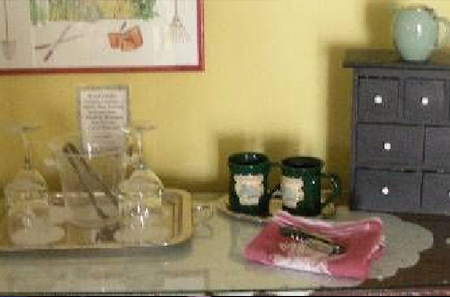While I was gone this weekend, MzRita asked a great question:
“I know I will probably make someone gasp when I ask this question, but I am planning a huge tea party at Christmas, with over 30 ladies in attendance, and I am wondering if it’s ok to brew the tea in one of those 50 cup coffee makers? I could dispense the tea from the big coffee maker directly into the tea pots. Will it taste ok this way?”
No one is gasping here at Tea Party Girl, MzRita. In fact, I’m applauding your choice to host a Christmas-themed tea and planning now! Good for you! I want to help you all I can (Christmas decoration article on its way.)
First, to answer MzRita’s question. Yes, you can use a 50-cup coffee maker with a few exceptions:
- Most likely, it’s already been used to brew coffee. Stick your nose in the brewer and take a whiff. It will need to be cleaned thoroughly because the water will pick up the coffee odors. The best way to do this is to run it through an entire cycle of baking soda and water, then rinse any residual baking soda out and take another whiff. Make sure it worked! Ideally, you would use a coffee urn that had never been used for coffee.
- Also, I recommend that you use the coffee brewer only to hold the water and still brew the tea in each individual pot. This is not ideal, as coffee doesn’t need the water to be quite so hot. Black and herb teas really need water as close to boiling as possible. But it will work.
- Before your event, line up the pots you will use. Measure out the amount of tea each pot needs in your strainer of choice and have them all ready to go. Right before serving, fill your pots with the water from the coffee brewer and brew for 3-4 minutes. Discard the leaves and serve.
Does that help?
This weekend, I visited two Bed and Breakfasts listed with Select Registry, meaning they’ve passed a thorough inspection (with 18 pages of rating, I’m told) by “secret sleepers” in order to be included as a distinguished inn of North America. I toured one and stayed in the other (more to come this week on THAT story!).
I mention it because these two inns of distinction had to “fake it” when it came to tea. Both inns provided a thorough refreshment bar of treats. The inn where I stayed laid out nuts, candies, chocolates, port and sherry, fresh cookies, and a number of instant hot drinks including tea.
They could have made looseleaf tea available. However, my guess it that too many of their guests wouldn’t know what to do with it. The majority of American tea drinkers still look for teabags, which both of these inns at their refreshment bars offered. Both inns offered two of the best and well-known teabag options, Mighty Leaf and Tea Forte. Mighty Leaf calls their teabags “tea pouches” not made of chemically-treated paper but a fabric I couldn’t find identified at their website. They keep the tea leaves as whole as possible. Tea Forte was the first, I believe, to introduce the pyramid-shaped silk infusers. Pricier than the typical paper and stapled teabags, sure, but both inns provided the best one can find in single-cup convenience tea.
At the inn where we stayed, they also provided us with a simplified tea bar in our room (and a plate of appetizers with a bottle of wine, but that’s another story). Here’s a picture:

The little chest you see was filled with a different flavor of Mighty Leaf tea pouches in each drawer. The teapot and mugs were provided, as you can see, AND a beverage water spigot for instant boiling water.
The bottom line? Sometimes you have to “fake it” when making tea for a crowd or on the road. Do what you can to provide the best ingredients, water, and ease while still maintaining the quality. Your guests will thank you (“Thank you, Dunbar House, 1880!”).


Yes, this article was very helpful. Thank you so much!
Thanks also for sharing the picture of the tea bar. How nice!
I am looking forward to your table decorating ideas for Christmas. Is there any such thing as Chic and Cheap? That’s what I am trying to pull off. *laughs*
Great advice, Tea Party Girl! I am hosting a talk on tea at a local church on Thursday. It’s a large group and I can’t talk and make tea at the same time, so I plan to use the Mighty Leaf “sachets”.
I have successfully used Mr. Coffee’s Iced Tea maker filling the water reservior two times. Nothing is ever on target like boiling water to brew tea in a pot but, this comes awfully close. The unit is made to brew tea so the water is hotter than for coffee. The plastic pitcher can with stand the hot tea temperature. The number of tea bags added determines the strength of the tea. I use one family size tea bag and 2 regular sized flavored tea bags, e.g. peppermint. Mummm good hot or cold